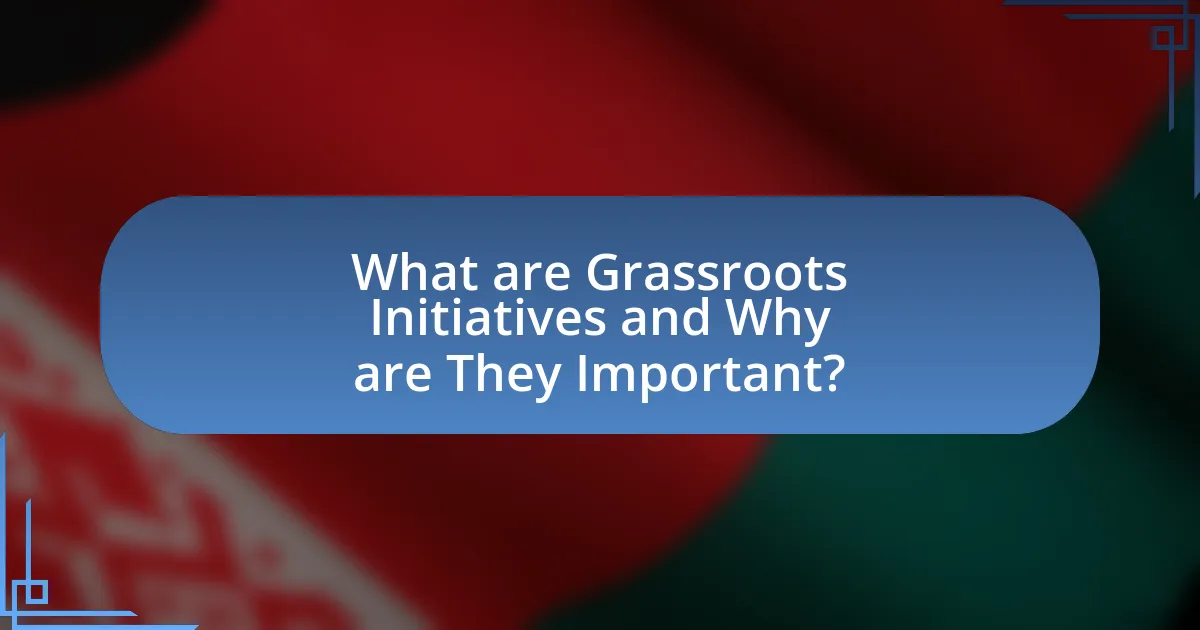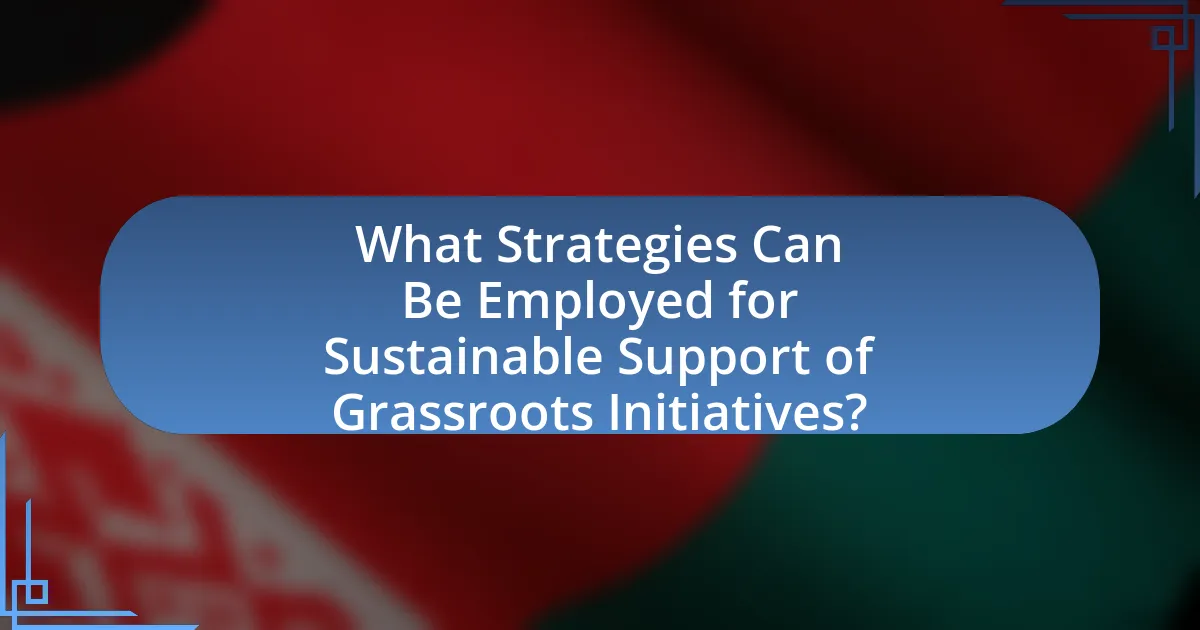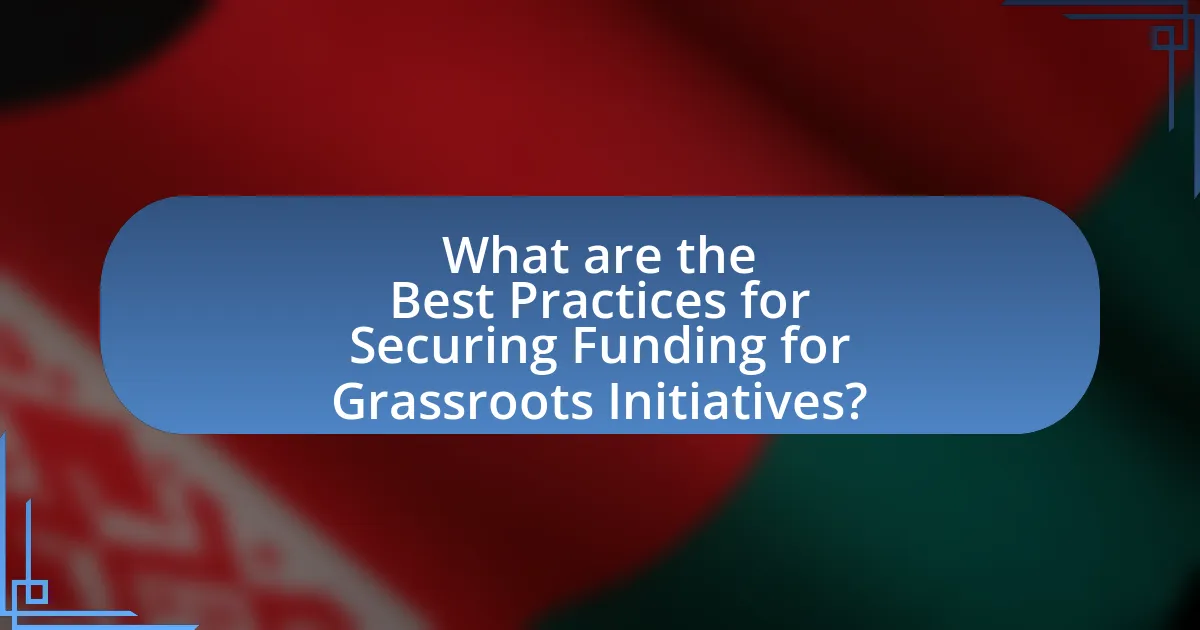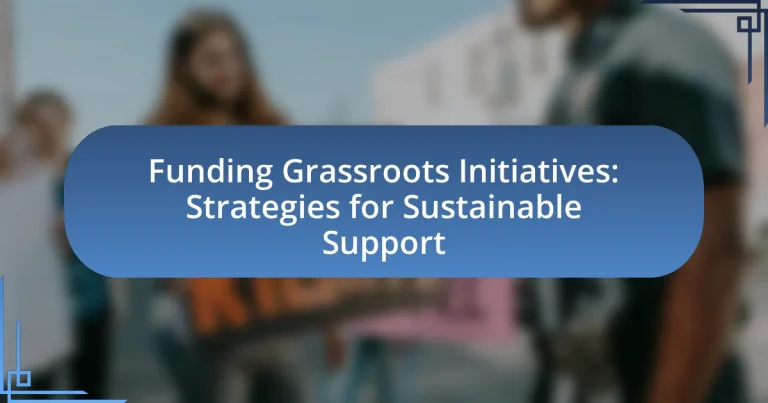Grassroots initiatives are community-driven efforts that address local issues and promote social change, emphasizing the importance of civic engagement and tailored solutions. This article explores the differences between grassroots initiatives and traditional funding models, highlighting their reliance on community support and small donations. It discusses key characteristics of grassroots initiatives, the significance of community involvement, and the challenges they face in securing funding, particularly in relation to economic and political factors. Additionally, the article outlines strategies for sustainable support, including community engagement, diversified funding sources, and effective storytelling, while also examining the role of partnerships and best practices for securing funding.

What are Grassroots Initiatives and Why are They Important?
Grassroots initiatives are community-driven efforts aimed at addressing local issues and promoting social change. These initiatives are important because they empower individuals and communities to take action, fostering civic engagement and creating solutions that are tailored to specific local needs. For example, a study by the National Civic League highlights that grassroots movements have historically played a crucial role in advancing civil rights and environmental justice, demonstrating their effectiveness in mobilizing community resources and influencing policy.
How do Grassroots Initiatives differ from traditional funding models?
Grassroots initiatives differ from traditional funding models primarily in their reliance on community-driven support rather than institutional or large-scale financial backing. Grassroots initiatives often mobilize local resources, engage community members directly, and emphasize small donations from individuals, which fosters a sense of ownership and accountability among participants. In contrast, traditional funding models typically involve larger grants from government entities, corporations, or foundations, which may impose specific requirements or conditions that can limit the flexibility and autonomy of the initiative. This distinction is evident in the success of grassroots movements, such as the crowdfunding campaigns that have raised millions for local projects, demonstrating the effectiveness of community engagement in funding efforts.
What are the key characteristics of Grassroots Initiatives?
Grassroots initiatives are characterized by community-driven efforts that prioritize local engagement and participation. These initiatives often emerge from the needs and interests of the community members themselves, fostering a sense of ownership and empowerment. They typically focus on social change, addressing specific local issues such as environmental concerns, social justice, or public health. Additionally, grassroots initiatives often rely on volunteer support and small-scale funding, emphasizing collaboration and resourcefulness over large institutional backing. This approach allows for adaptability and responsiveness to the community’s evolving needs, as evidenced by numerous successful local movements that have led to significant policy changes or community improvements.
Why is community involvement crucial in Grassroots Initiatives?
Community involvement is crucial in grassroots initiatives because it fosters local ownership and ensures that the initiatives address the specific needs of the community. When community members actively participate, they contribute valuable insights and resources, which enhances the effectiveness and sustainability of the initiative. Research indicates that initiatives with strong community engagement are more likely to succeed; for example, a study by the National Civic League found that communities with high levels of civic engagement experience better outcomes in public health and education. This direct involvement not only builds trust but also mobilizes additional support and funding, making grassroots initiatives more resilient and impactful.
What challenges do Grassroots Initiatives face in securing funding?
Grassroots initiatives face significant challenges in securing funding, primarily due to limited access to traditional funding sources and a lack of visibility. Many grassroots organizations operate on tight budgets and often lack the necessary connections to larger funding bodies, which can result in difficulties in obtaining grants or donations. According to a report by the National Council of Nonprofits, 70% of small nonprofits struggle to secure funding due to competition with larger organizations that have established relationships with funders. Additionally, grassroots initiatives may not have the capacity to effectively communicate their impact or needs, further hindering their ability to attract financial support.
How do economic factors impact funding for Grassroots Initiatives?
Economic factors significantly influence funding for grassroots initiatives by determining the availability of financial resources and the willingness of donors to contribute. For instance, during economic downturns, individuals and organizations often reduce their charitable giving due to decreased disposable income, which directly impacts the funding available for grassroots projects. According to a report by the Giving USA Foundation, total charitable giving in the United States decreased by 1.7% in 2020, reflecting the economic challenges posed by the COVID-19 pandemic. Additionally, economic conditions can affect government funding and grants, as budget constraints may lead to cuts in public funding for community-based programs. Therefore, the overall economic climate plays a crucial role in shaping the financial landscape for grassroots initiatives.
What role does political climate play in the funding landscape?
The political climate significantly influences the funding landscape by shaping priorities and resource allocation for various initiatives. For instance, during periods of political stability and support for social programs, funding for grassroots initiatives tends to increase, as seen in the expansion of community development grants during the Obama administration. Conversely, in politically charged environments where austerity measures are prioritized, funding for such initiatives often diminishes, as evidenced by cuts to social programs during the Trump administration. This dynamic illustrates how shifts in political leadership and policy can directly impact the availability and distribution of financial resources for grassroots efforts.

What Strategies Can Be Employed for Sustainable Support of Grassroots Initiatives?
Sustainable support for grassroots initiatives can be achieved through community engagement, diversified funding sources, and capacity building. Community engagement fosters local ownership and ensures that initiatives align with the needs of the population, as evidenced by the success of participatory budgeting in cities like Porto Alegre, Brazil, which increased civic participation and resource allocation efficiency. Diversified funding sources, including grants, crowdfunding, and partnerships with local businesses, enhance financial stability; for instance, the GlobalGiving platform has enabled numerous grassroots projects to secure funding from a wide array of donors. Capacity building through training and mentorship equips grassroots organizations with the skills necessary for long-term sustainability, as demonstrated by the work of organizations like Ashoka, which supports social entrepreneurs in developing effective operational strategies.
How can community engagement enhance funding opportunities?
Community engagement enhances funding opportunities by fostering trust and demonstrating community support for initiatives. Engaged communities are more likely to mobilize resources, attract donors, and secure grants, as funders often prioritize projects with visible local backing. For instance, a study by the National Endowment for the Arts found that organizations with strong community ties received 50% more funding than those without such connections. This evidence illustrates that active participation and collaboration within the community can significantly increase the likelihood of obtaining financial support for grassroots initiatives.
What methods can be used to mobilize community support?
To mobilize community support, grassroots organizations can utilize methods such as community engagement, social media campaigns, and partnerships with local businesses. Community engagement involves organizing events and forums that encourage participation and dialogue among residents, fostering a sense of ownership and commitment to local initiatives. Social media campaigns can effectively raise awareness and rally support by sharing compelling stories and calls to action, reaching a wider audience quickly. Additionally, forming partnerships with local businesses can provide resources and credibility, as these entities often have established relationships within the community. These methods have been shown to enhance community involvement and support for various initiatives, as evidenced by successful case studies in community organizing and local activism.
How can grassroots organizations build strong networks for funding?
Grassroots organizations can build strong networks for funding by actively engaging with local communities, establishing partnerships with other organizations, and leveraging social media for outreach. Engaging with local communities fosters trust and support, which is essential for attracting funding. For instance, organizations that host community events or workshops can create a sense of belonging and encourage local investment. Establishing partnerships with other nonprofits or businesses can enhance resource sharing and broaden funding opportunities, as collaborative projects often attract more attention from funders. Additionally, utilizing social media platforms allows grassroots organizations to reach a wider audience, share their mission, and connect with potential donors. According to a report by the National Council of Nonprofits, organizations that effectively use social media can increase their visibility and funding prospects significantly.
What role do partnerships play in funding Grassroots Initiatives?
Partnerships play a crucial role in funding grassroots initiatives by providing essential resources, expertise, and networks that enhance the initiatives’ sustainability and reach. These collaborations often combine financial contributions from various stakeholders, including non-profits, government agencies, and private sector entities, which can significantly increase the available funding pool. For instance, a study by the Stanford Social Innovation Review highlights that partnerships can lead to a 50% increase in funding for grassroots projects, as they leverage shared goals and resources to attract more investment. This collaborative approach not only amplifies financial support but also fosters community engagement and capacity building, ensuring that grassroots initiatives are more effective and resilient in addressing local challenges.
How can collaborations with local businesses improve funding prospects?
Collaborations with local businesses can significantly improve funding prospects by creating mutually beneficial partnerships that enhance resource sharing and community engagement. When grassroots initiatives partner with local businesses, they often gain access to financial support, in-kind donations, and increased visibility within the community. For instance, a study by the National Federation of Independent Business found that 70% of small businesses are more likely to support local initiatives that align with their values, demonstrating a strong willingness to invest in community projects. This collaboration not only provides immediate funding but also fosters long-term relationships that can lead to sustained financial support and shared marketing efforts, ultimately enhancing the initiative’s credibility and reach.
What are the benefits of partnering with non-profit organizations?
Partnering with non-profit organizations provides access to specialized expertise and community trust, enhancing the effectiveness of initiatives. Non-profits often have established relationships within communities, which can facilitate outreach and engagement. For instance, a study by the Stanford Social Innovation Review highlights that collaborations between businesses and non-profits can lead to increased social impact, as non-profits bring valuable insights into local needs and challenges. Additionally, such partnerships can improve brand reputation and customer loyalty for businesses, as consumers increasingly prefer companies that demonstrate social responsibility.

What are the Best Practices for Securing Funding for Grassroots Initiatives?
The best practices for securing funding for grassroots initiatives include building strong community relationships, creating a clear and compelling project proposal, and diversifying funding sources. Strong community relationships foster trust and support, which can lead to increased local contributions and volunteer efforts. A clear and compelling project proposal outlines the initiative’s goals, impact, and budget, making it easier for potential funders to understand the value of the project. Diversifying funding sources, such as seeking grants, donations, and crowdfunding, reduces reliance on a single source and increases financial stability. According to the National Council of Nonprofits, organizations that diversify their funding are more resilient and better positioned to sustain their initiatives over time.
How can effective storytelling attract funding for Grassroots Initiatives?
Effective storytelling can attract funding for grassroots initiatives by creating an emotional connection with potential donors, illustrating the impact of their contributions. When grassroots organizations share compelling narratives that highlight personal experiences and community challenges, they engage funders on a deeper level, making the cause relatable and urgent. Research indicates that narratives that evoke empathy can increase donor engagement by up to 50%, as they help funders visualize the positive change their support can facilitate. By effectively communicating the mission, vision, and tangible outcomes of their initiatives through storytelling, grassroots organizations can significantly enhance their appeal to potential investors and secure necessary funding.
What elements make a compelling narrative for potential funders?
A compelling narrative for potential funders includes a clear mission, a relatable story, measurable impact, and a strong call to action. The mission articulates the purpose and goals of the initiative, making it easy for funders to understand the vision. A relatable story engages emotions, illustrating real-life experiences that resonate with the audience. Measurable impact provides concrete data or case studies demonstrating the effectiveness of the initiative, which is crucial for funders to assess the potential return on their investment. Lastly, a strong call to action motivates funders to contribute by clearly outlining how their support will make a difference. These elements collectively enhance the narrative’s persuasiveness, increasing the likelihood of securing funding.
How can data and impact metrics strengthen funding proposals?
Data and impact metrics can strengthen funding proposals by providing quantifiable evidence of a project’s effectiveness and potential for success. When funding proposals include specific data points, such as the number of beneficiaries served or measurable outcomes achieved, they demonstrate accountability and transparency to potential funders. For instance, a study by the Stanford Social Innovation Review found that organizations that effectively communicated their impact metrics were 50% more likely to secure funding compared to those that did not. This evidence-based approach not only builds trust with funders but also aligns the proposal with their strategic priorities, increasing the likelihood of financial support.
What funding sources should Grassroots Initiatives consider?
Grassroots Initiatives should consider a variety of funding sources including individual donations, crowdfunding platforms, grants from foundations, corporate sponsorships, and government funding. Individual donations provide direct support from community members who believe in the initiative’s mission. Crowdfunding platforms like Kickstarter or GoFundMe allow grassroots organizations to reach a wider audience and gather small contributions from many supporters. Grants from foundations, such as the Ford Foundation or the Rockefeller Foundation, can provide substantial funding for specific projects or operational costs. Corporate sponsorships can also be beneficial, as businesses often seek to enhance their corporate social responsibility profiles by supporting community initiatives. Lastly, government funding, available through local, state, or federal programs, can offer significant financial resources for grassroots efforts aimed at social change. These funding sources are essential for sustaining operations and achieving long-term goals.
What are the advantages of applying for grants versus crowdfunding?
Applying for grants offers several advantages over crowdfunding, primarily in terms of funding stability and credibility. Grants typically provide larger sums of money that do not require repayment, allowing organizations to focus on long-term projects without the pressure of immediate financial returns. Additionally, grants often come from established institutions, which can enhance the credibility of the recipient organization and attract further funding opportunities. For instance, according to the National Council of Nonprofits, grant funding can range from thousands to millions of dollars, significantly surpassing typical crowdfunding amounts, which often rely on smaller contributions from a larger number of individuals. This financial backing can lead to more sustainable initiatives, as organizations can allocate resources more effectively without the uncertainty associated with crowdfunding campaigns.
How can grassroots organizations leverage social media for fundraising?
Grassroots organizations can leverage social media for fundraising by creating engaging content that resonates with their target audience and encourages donations. By utilizing platforms like Facebook, Instagram, and Twitter, these organizations can share compelling stories, showcase their impact, and foster a sense of community among supporters. For instance, a study by the Pew Research Center found that 69% of adults in the U.S. use social media, providing a vast audience for outreach. Additionally, campaigns that include clear calls to action and utilize features like donation buttons or fundraising events can significantly increase contributions. According to a report from Classy, social media fundraising campaigns can generate up to 14 times more donations than traditional methods, highlighting the effectiveness of this approach.
What are practical tips for sustaining funding over time?
To sustain funding over time, grassroots initiatives should diversify their funding sources, build strong relationships with donors, and demonstrate impact through transparent reporting. Diversifying funding reduces reliance on a single source, which can be risky; for instance, organizations that secure funding from multiple grants, individual donors, and corporate sponsorships are less vulnerable to fluctuations in any one area. Building relationships with donors fosters trust and encourages ongoing support; studies show that personalized communication increases donor retention rates. Additionally, demonstrating impact through clear metrics and regular updates can enhance accountability and encourage continued investment, as donors are more likely to support initiatives that show tangible results.


